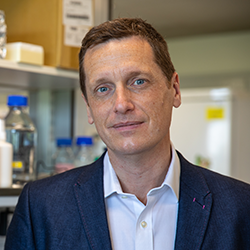- Group Leader, Early Cancer Institute
- Honarary Consultant in Hepatology, Addenbrooke's Hospital
- Assistant Professor in Hepatology
- University of Cambridge Specialty Director for Undergraduate Clinical Medicine
Biography
Matt is Assistant Professor of Hepatology at the University of Cambridge, based at the Early Cancer Institute and hepatologist at Addenbrooke's Hospital in Cambridge. He leads the East of England service for hepatocellular carcinoma (HCC), seeing patients from across the region and contributing to numerous observational and interventional clinical trials in HCC.
His research interests centre around the diseased liver microenvironment and why this drives carcinogenisis. He completed his PhD at the Department of Medicine in Cambridge, investigating the presence and functionality of senescent immune cells in the liver microenvironment, in chronic viral hepatitis infection (1, 2), after liver transplantation (3, 4), and their relationship to clinical outcomes (5).
During post-doctoral fellowships at the CRUK Cambridge Institute, he investigated mechanisms of senescence secretome control. Senescent cells have been identified in various pre-malignant conditions, where they have profound and sometimes contrasting effects upon their environment through their secretome. However, the pathways controlling this differential functionality in the senescence secretome were previously unclear. He defined the role of NOTCH1 (6, 7) and COX2 (8), in the modulation of both secretome composition and long-term tumorigenesis in the liver microenvironment.
More recently he has defined the genomic consequences of chronic liver disease, allowing us to understand the burden of DNA damage and the clonal dynamics of cirrhotic nodules in CLD (9, 10). This work has developed an understanding of the cancerisation field effect that exists in CLD. These findings have the potential to be disruptive to our understanding of the pathogenesis of CLD, translate into novel biomarkers of prognosis in CLD and potentially actionable therapeutic targets.
Publications list:
Google Scholar: https://scholar.google.co.uk/citations?user=EmZhvwcAAAAJ&hl=en
Key Publications
- Yin K, Patten D, Gough S, de Barros Gonçalves S, Chan A, Olan I, Cassidy L, Poblocka M, Zhu H, Lun A, Schuijs M, Young A, Martinez-Jimenez C, Halim T, Shetty S, Narita M*, Hoare M*. Senescence-induced endothelial phenotypes underpin immune-mediated senescence surveillance. Genes and Development, 2022, 36(9-10):533-549. * Co-corresponding authors
- Ng SWK, Rouhani FJ, Brunner SF, Brzozowska N, Aitken SJ, Yang M, Abascal F, Moore L, Nikitopoulou E, Chappell L, Leongamornlert D, Ivovic A, Robinson P, Butler T, Sanders A, Williams N, Coorens THH, Teague J, Raine K, Butler AP, Hooks Y, Wilson B, Birtchnell N, Naylor H, Davies SE, Stratton MR, Martincorena I, Rahbari R, Frezza C, Hoare M*, Campbell PJ*. Convergent somatic mutations in effectors of insulin signalling in chronic liver disease. Nature, 2021, 598 (7881) 473-478. * Co-corresponding authors
- Gonçalves S, Yin K, Ito Y, Chan, A, Olan I, Gough S, Cassidy L, Serrao E, Smith S, Young A, Narita M, Hoare M. COX2 regulates senescence secretome composition and senescence surveillance through PGE2. Cell Reports, 2021, 34(11):108860.
- Brunner SF, Roberts ND, Wylie LA, Moore L, Aitken SJ, Davies SE, Sanders MA, Ellis P, Alder C, Hooks Y, Abascal F, Stratton MR, Martincorena I, Hoare M*, Campbell PJ*. Somatic mutations and clonal dynamics in healthy and cirrhotic human liver. Nature, 2019, 574 (7779) 538. * Co-corresponding authors
- Hoare M, Ito Y, Kang TW, Weekes MP, Matheson NJ, Patten DA, Shetty S, Parry AJ, Menon S, Salama R, Antrobus R, Tomimatsu K, Howat W, Lehner PJ, Zender L, Narita M. NOTCH1 mediates a switch between two distinct secretomes during senescence. Nature Cell Biology, 2016, 18(9) 979-992.
Hepatocellular carcinoma (HCC) is the fourth leading cause of cancer-related death worldwide. 90% of HCC develops in patients with chronic liver disease (CLD); the causes of CLD are changing, with rapidly rising obesity and type 2 diabetes driving non-alcoholic fatty liver disease (NAFLD). Patients with CLD form a clear at-risk population for HCC development, amenable to early detection. The liver in CLD is marked by a cancerisation field effect; the mechanistic basis of this is unknown.
We hypothesised that it could be encoded at HCC-associated genomic loci. We used whole genome sequencing of non-malignant human CLD tissue, but did not find HCC-associated driver mutations. We identified recurrent somatic mutations in several disease-relevant genes, including FOXO1 (insulin and AMPK signalling) and ACVR2A (activin signalling), with evidence of convergent evolution in the same liver. Mutations in FOXO1 are at a single AMPK phospho-site and we have found that these mutations are functional.
We aim to understand the role of these recurrent somatic mutations in the cancerisation field effect of CLD, to understand HCC development. We hypothesise they will be:
- Functional in diseased hepatocytes, leading to mechanistic insights into HCC pathogenesis;
- Functional in mouse models of CLD, modulating the development of HCC;
- Identifiable in CLD patients, with potential as diagnostic and prognostic biomarkers.
If successful, we will develop new insights into the cancerisation field effect in CLD and pathogenesis of HCC, novel biomarkers of CLD prognosis and potentially actionable targets in this disease of unmet need.

